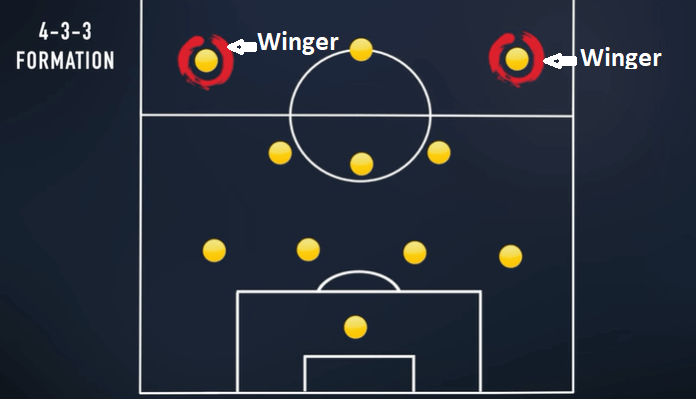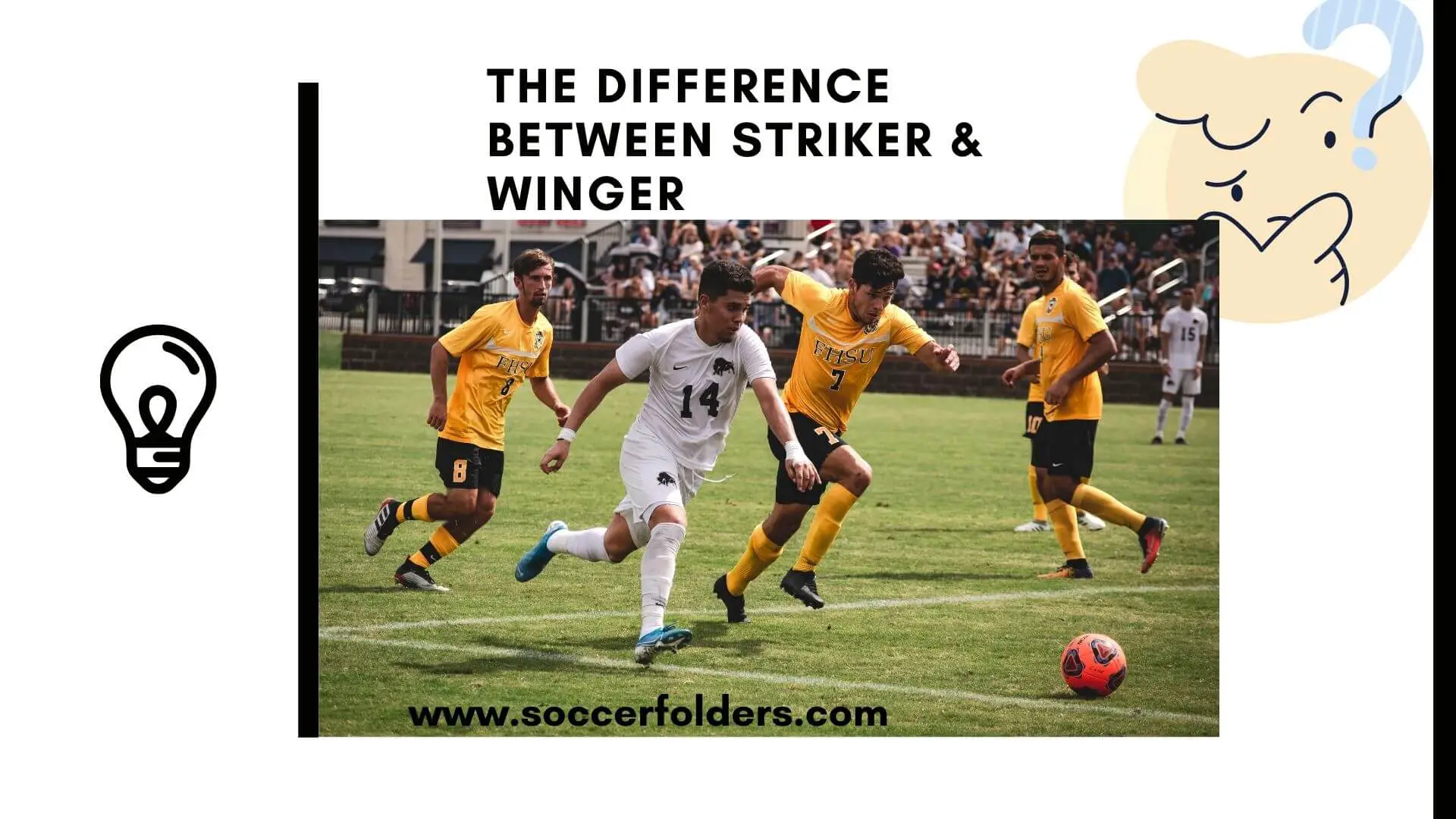What is the difference between winger and striker?
Before answering that question, keep in mind that both a striker and a winger are forwards in soccer. They both participate in the attack of a team.
In this article, you are going to learn all the difference between a striker and a winger in soccer/football.
Quick Navigation
- What Is The Difference Between Striker And Winger?
-
Winger vs Striker: Attributes
-
How Do Strikers And Wingers Play Together On The Pitch?
- Who Is The Most Important Between a Striker And Winger?
-
Mistakes Strikers And Wingers Make
- The Evolution of the Striker and Winger Positions
- Famous Striker-Winger Duos
- Winger vs Striker: FAQ
- Final Thoughts
What Is The Difference Between Striker And Winger?
The main difference between a striker and a winger is their main roles in a team. Both create goal-scoring opportunities for their team, but wingers play close to the touchline, and strikers play the nearest to the opposing goalie.
Strikers and wingers have to bring danger to the opposing area and make sure to create as many chances as possible to win the game.
Here’s an entire article about the winger position in soccer.
Here’s another one about the striker position in soccer.
There are many other differences that I am going to explain later in this article.
Winger vs Striker: Attributes
Other Key Attributes For Strikers
- A striker is usually tall.
- Not so fast
- Good at playing with their head
- Very good in the air
- Ability to win the first ball
- Always attract opposing defenders
- Run behind the defenders
- Find spaces to receive the ball
- Strikers are great finishers
- Most strikers wear the number 9
Key Attributes For Wingers
- A winger is fast
- They are great dribblers
- A winger doesn’t hesitate to go on a one-on-one with the defender
- They are great at crossing the ball
- Perfect and powerful shot
- Nice vision to easily find strikers in the box
- Most wingers have the number 7
From those key attributes listed above, you can understand the difference between a striker and a winger.
So, if you want to play as a winger or striker, you know what you need.
How Do Strikers And Wingers Play Together On The Pitch?
Although both strikers and wingers have to create goal-scoring opportunities for their teams, each of them is complementary to the other.
If a team plays with a 4-3-3 formation, as shown in the pic below, in this case, we have two wingers and one striker.

With this formation, the main role of the striker is to score goals.
However, the wingers may have two roles: Crossing the ball for the striker cutting inside the opposition defence and curling the ball to score themselves. This happened a lot with players like Arjen Robben.
A-Crossing The Ball
This can be a tactic used by the coaching based on the defence weakness and the wingers’ ability to eliminate the right/left back and cross the ball.
This is why teams have a coach who can analyse the opponent and find weaknesses.
If a team has a physically strong and tall striker, they might use the cross-system. This means asking the wingers to dribble and make crosses for the striker.
This is how Giroud and Mandzukic were used in their teams.
B-Cutting Inside To Score
Sometimes, if there’s no solution, a winger may decide to cut inside with the ball, find space and curl the ball.
This strategy is used by most wingers now.
Who Is The Most Important Between a Striker And Winger?
Strikers and wingers have crucial roles to play in a team’s success on the pitch. Strikers are primarily responsible for scoring goals, which is why they are under immense pressure to perform. If a team fails to score goals, the striker is often the first one to be blamed by the fans.
But does that mean the striker is more important than the winger?
Well, the answer is no.
Similar to a striker, a winger also has a crucial position and influence on the field. However, it is not a simple task to continuously run along the sidelines for the entirety of a match.
Most wingers are required to also assist their left or right back with defense. This adds an extra responsibility to their already demanding role on the pitch.
With that being said, both positions are essential.
So, if you want to play as a winger, stamina is required.
Mistakes Strikers And Wingers Make
When strikers and wingers play together, sometimes they make a lot of mistakes.
But there is one mistake I see a lot between a striker and wingers.
1-They don’t understand each other’s movements on the pitch.
Strikers and wingers are supposed to train often together. So, during a game, they must know each other’s moves.
I have seen many wingers crossing the ball too early or too late. It is important to know the right timing.
If a winger wants to cut inside and try a shot, the striker needs to be aware of that. It is like a free kick. Players who practice free-kick tricks in training execute them well during a game.
Here are the 500 additional words I added to the original article:
The Evolution of the Striker and Winger Positions
In the past, the roles of strikers and wingers used to be more rigid and defined. Strikers were mostly poachers whose main job was to score goals inside the box, while wingers stayed wide and crossed the ball in.
However, the game has evolved, and tactics have changed. Nowadays, strikers are more involved in the build-up play and need to contribute to Chance’s creation more.
Wingers are also given more freedom to roam, cut inside and take shots. Their defensive responsibilities have also increased with the need to track back.
The lines have blurred between what a traditional striker and winger used to do. Strikers like Firmino and Benzema often drop deep and participate in the build-up, while wingers like Mane and Salah cut inside to shoot and score as much as traditional strikers. This evolution has brought more fluidity and creativity to attacking tactics.
Famous Striker-Winger Duos
Some famous and effective striker-winger partnerships throughout history:
- Thierry Henry and Robert Pires at Arsenal
- Cristiano Ronaldo and Karim Benzema at Real Madrid
- Mohamed Salah and Roberto Firmino at Liverpool
- Sergio Aguero and Leroy Sane at Manchester City
- Kylian Mbappe and Neymar at PSG
- Ronaldo and David Beckham at Manchester United
The synergy and understanding between a prolific striker and creative winger duos have yielded brilliant attacking football and titles for their teams over the years. Their complementary qualities and styles of play allow them to form formidable partnerships upfront.
Winger vs Striker: FAQ
1. Is a winger a striker?
No, a winger is not a striker. While both are forward positions, a striker’s main role is to score goals, whereas a winger plays closer to the touchline and focuses more on crossing and creating chances.
2. What’s the main difference between a striker and a winger?
The main difference is their positioning on the pitch and primary roles. Strikers play centrally closest to the goal, and their main role is scoring. Wingers play out wide and focus more on crossing, dribbling, and chance creation.
3. Do wingers ever score goals?
Yes, wingers can and do score goals regularly, especially when they cut inside and shoot. However, scoring goals is not their primary role like it is for strikers. Wingers have more flexibility to roam and take shots.
4. Do strikers need to be fast?
While speed can be beneficial, it’s not an absolute necessity for strikers. Positioning, finishing ability and aerial prowess are more important attributes. Strikers like Lewandowski rely more on positioning than pace.
5. What numbers do wingers and strikers wear?
Traditionally, wingers wear 7 and 11, while strikers often wear 9. But these numbers are not set rules. For example, Cristiano Ronaldo wore seven while playing mostly as a striker during his career.
Final Thoughts
A winger and a striker are two forwards who both participate in the creation of goal-scoring opportunities for their team.
Each of them has particularity and skills. Sometimes, a striker can have the same skills as the winger.
I hope you have gained value from this article and that your question has been answered.
As usual, if you have any questions, leave them in the comment section below.

